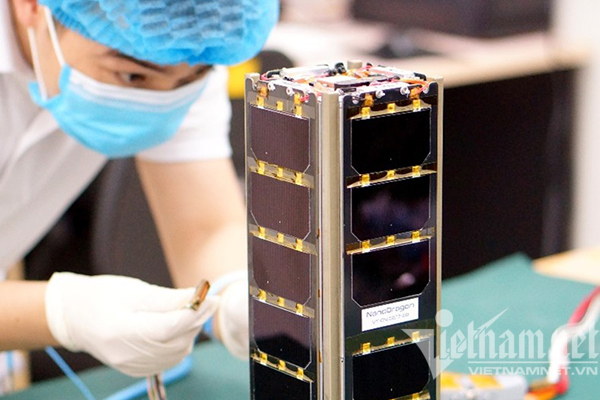 |
| NanoDragon satellite officially transferred to the Japan Aerospace Exploration Agency on August 17. — Photo courtesy of the Vietnam National Space Centre |
In the era of rapid development of science and technology, and as the development of space science and technology in Vietnam is set to meet the needs of the 4th Industrial Revolution, towards the nation’s industrialisation and modernisation, there are many opportunities and also many challenges.
Le Xuan Huy, Deputy General Director of the Vietnam Space Center under the Vietnam Academy of Science and Technology said the strategy for development and application of space science and technology until 2030, dated February 4, 2021, was approved with the general objectives, including applying achievements of space science and technology; focused investment in a number of fields related to national defence and security, natural resources and environmental management, monitoring and support to reduce damage caused by natural disasters, providing a variety of other services.
“The strategy has shown the Party and State's interest in the development of space science and technology in the country, it also creates many opportunities for scientists, manufacturers, businesses and stakeholders in this field,” Huy said.
For this field, Vietnam has had important milestones. In 1980, Pham Tuan was the first Asian astronaut to fly into space. In 2006, the Space Technology Research and Development Strategy towards 2020 was approved by the Government. In 2008, Vietnam made VINASAT-1 satellite, its first telecommunications satellite. In 2012, the Vietnam Space Center Project was started. In 2013, Vietnam's first remote sensing satellite, VNREDSat-1, was launched into orbit. Also in 2013, PicoDragon satellite was the first satellite completely manufactured by Vietnam (weighing 1kg). In 2019, the MicroDragon satellite, which weighs 50kg, was made by 36 Vietnamese engineers and supported by many Japanese professors in the design and development process.
Most recently, the NanoDragon satellite, made entirely in Vietnam, was also moved to the Uchinoura Space Center launch site, Kagoshima Prefecture, in southern Japan. It is expected to be launched into orbit on October 1, 2021.
The satellites that Vietnam owns have brought many benefits to socio-economic development, including in environmental monitoring, meteorology, mapping, forecasting and impact assessment of climate change, effective detection of illegal fishing vessels; analysis of long-term water pollution trends; monitoring rice cultivation and detecting natural phenomena related to agriculture such as drought and salinity damage, as well as collecting data on local forest status in remote areas, Huy said.
The strategy for development and application of space science and technology towards 2030 has solutions for human resources development for the field, including establishment and upgrading of at least five training institutions; developing training codes, programme frameworks, and output standards for aeronautics and spaceflight majors; developing strong research groups, including about five groups on space science and 15 groups on space technology.
Huy said the development of space science technology in Vietnam still faces many difficulties and challenges such as limited infrastructure, financial resources, human resources, and supporting industries. Therefore, besides realising the common goals, it is urgent to pay attention to the development of human resources in science and technology in the future.
In particular, he said, in order to develop space science and technology in our country, it is also necessary to involve the young generation right now, nurture their passion, raise awareness and understanding about science and technology, about the universe; prepare for them the capacity, skills, teamwork skills, and professional working style.
General Director of Vietnam Space Center Pham Anh Tuan said that the Party and State should define outer space as one of five spaces (land, airspace, sea, cyberspace and outer space) that Vietnam needs to master to protect national interests.
In addition, space technology requires a large investment of financial resources, human resources and time, he said.
“Without a guarantee of direction, it is very difficult for an organisation to dare to invest. The Party and Government need to ensure a balanced and sustainable development orientation for this field by formulating Vietnam's Law on Space, which is a premise for other sectors to feel secure in investment and development,” Tuan said.
In addition, in order to develop space science as well as the space industry, Vietnam needs to promote the need to exploit applications from space technology, creating an attractive enough demand for economic sectors and technology start-ups. At the same time, the State needs to have policies to mobilise human resources with a good working environment, good remuneration policies, to attract and prepare the human resources.
Source: Vietnam News

Vietnam's NanoDragon microsatellite to be launched in Japan
Vietnam has sent NanoDragon satellite to Japan to hand over to the Japan Aerospace Exploration Agency (JAXA) to launch into space.

Strategy issued for space science-technology development, application
Prime Minister Nguyen Xuan Phuc has signed off a strategy for the development and application of space science and technology by 2030.